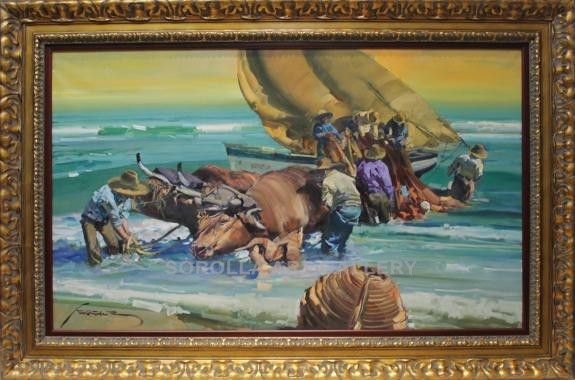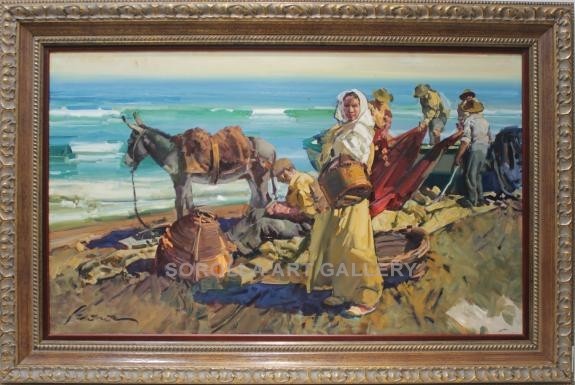Categories
EUSTAQUIO SEGRELLES


Eustaquio Segrelles del Pilar is a complete and prolific artist of the Spanish art scene, whose artistic creation gravitates between the twentieth and twenty-first century; he drinks from the Costumbrist themes, interpreting them though his particular vision full of light and strength. Artist and sculptor, his career began within the editorial illustration and achieved his height thanks to his frequent exhibitions in the international art market. He thus sold a considerable amount of paintings, mainly of marine and rural scenes.
Segrelles reaches perfection with 'Don Quixote' and 'The Carnival of Venice' as star topics. So much so that since 2005 every winner of the Cervantes Prize for Literature receives a copy of the novel, illustrated by the artist, accompanied by an original drawing as a dedication. It is a book that has become part of the official protocol.
The collection of original paintings that illustrate this deluxe edition of Don Quixote by Cervantes is exhibited in the town museum of Alcalá de Henares, which was the birthplace of Miguel de Cervantes Saavedra, the famous creator 'Don Quixote' .
Impressionism marked Segrelles' artwork with its aesthetic imprint. The Levantine light and landscapes, farms and noble, humble traditions are assiduously reflected in his canvases, which are made from sketch to canvas with colored rotundity and realism. The luxury of detail and elements is depicted through abundance of oil paint.
Tradition and work, effort and exhibition, are emerging creative combinations of his art skills.
He was born in Albaida in 1936, to a family of artists. His father, Ramiro Segrelles Albert, died in 1946, had also been a painter, like his famous uncle José Segrelles Albert (1885-1969). The young Eustaquio dreamt of being an artist, and that is why he studied Fine Arts and improved his skills. At age 18 he started to paint with oil and developed a penchant for drawing. At that age, with discipline and talent, he entered the publishing world as an illustrator. He began to exhibit at 21 years of age.
Segrelles developed an intense career as an artist, and devoted himself day by day to his vocation. He created about 10,000 paintings of all sizes durgin his life, denoting a great artistic capacity. If we should describe his way of working with only two words, we would say' balanced composition'. Whether it be seafood or fruits of the field, among all there is a visually recognizable balance, a scene focus, with the characters in their tasks, unaware of the eyes which are observing every vein, every point, every artistic breath. Compact crowds of farmers and fishers with the same old tools which are never modern or mechanised. There is no gasoline to move tractors in those canvases, no engines that push against the swell, and sweat smells of oil and not of human odors produced by the intense effort.
María del Rosario Caballero Pallás
Journalist and writer
Segrelles is as master of Valencian painting. Sorolla is his inspiration and mirror.
It's easy to put a label on him, it's easy to classify him.
But above this label there is another one: the communicator. Levantine painting is a very broad field, it is a wild card that works well -and Eustaquio Segrelles knows much about jokers-; It is easy to classify him, fit him within a group, school or trend. But his work is something else. Above themes, pictorial solutions and ways of handling light, there is an important and basic thing: Eustaquio Segrelles is a born communicator.
In the bottom or the top, painters can perhaps be divided between non communicators and communicators, between artists who can connect with the audience and artists for whom that is a hard thing to achieve. It is clear that each sector or social group has its particular communicative key, but there are unwritten and generic laws that make some artists able to communicate with a wider public, with a social spectrum from the humble wench to the haughty princess. And these artists are the chosen ones. They have a secret, a magic, which make them communicators.
Above technical and stylistic abilities there is the skill of transmitting knowledge through painting. And this, which might apparently seem easy, is actually difficult, very difficult. It is evidenced by the fact that born communicators are few, very few; You can count them with the fingers of one hand. And Eustaquio Segrelles is one of these few gifted artists. This we can know for a fact. And the rest is mere speculation.
C. Cañada
Journalist
Somewhere in Valencia ... there lived not long since one of those gentlemen who kept his brush in the yard ... inspiring canvases and color alacrity.
Our knight carries on with his duty, and even despite the bad weather, he knows - like Don Quixote- not to take a step back, especially when he has a rescue labour at hand, but to defend the task with the boldness, vigor and determination it deserves.
Eustaquio plays with a particular sensitivity that belongs to the literary world of Cervantes. He transforms Cervante's words into brush strokes, with a passionate visual communication full of longings.
Segrelles painting narrates the Quixotic exploits through image, revives and describes it, because ink and painting are but two intertwined forms of narrative.
Beatriz Vázquez
Art historian

